Analyzing Leisure Shopping Behavior's Impact on Marketing Initiatives
VerifiedAdded on 2023/01/20
|14
|3102
|98
Literature Review
AI Summary
This literature review examines the impact of changing consumer leisure shopping behavior on marketing strategies. It explores the evolution of luxury shopping, shifting from traditional values of elegance to experience-based products, especially among millennials. The review analyzes how consumer behavior influences marketing initiatives, including the shift from product exclusivity to transparency and practicality. It discusses the importance of online research and peer recommendations in shaping consumer decisions, and the impact on pricing, promotions, and product development. The review highlights the need for luxury brands to adapt their marketing approaches to meet the evolving expectations of consumers, emphasizing the significance of experience and value proposition. The paper identifies research gaps and limitations, concluding with insights into the dynamic relationship between leisure shopping behavior and marketing practices.
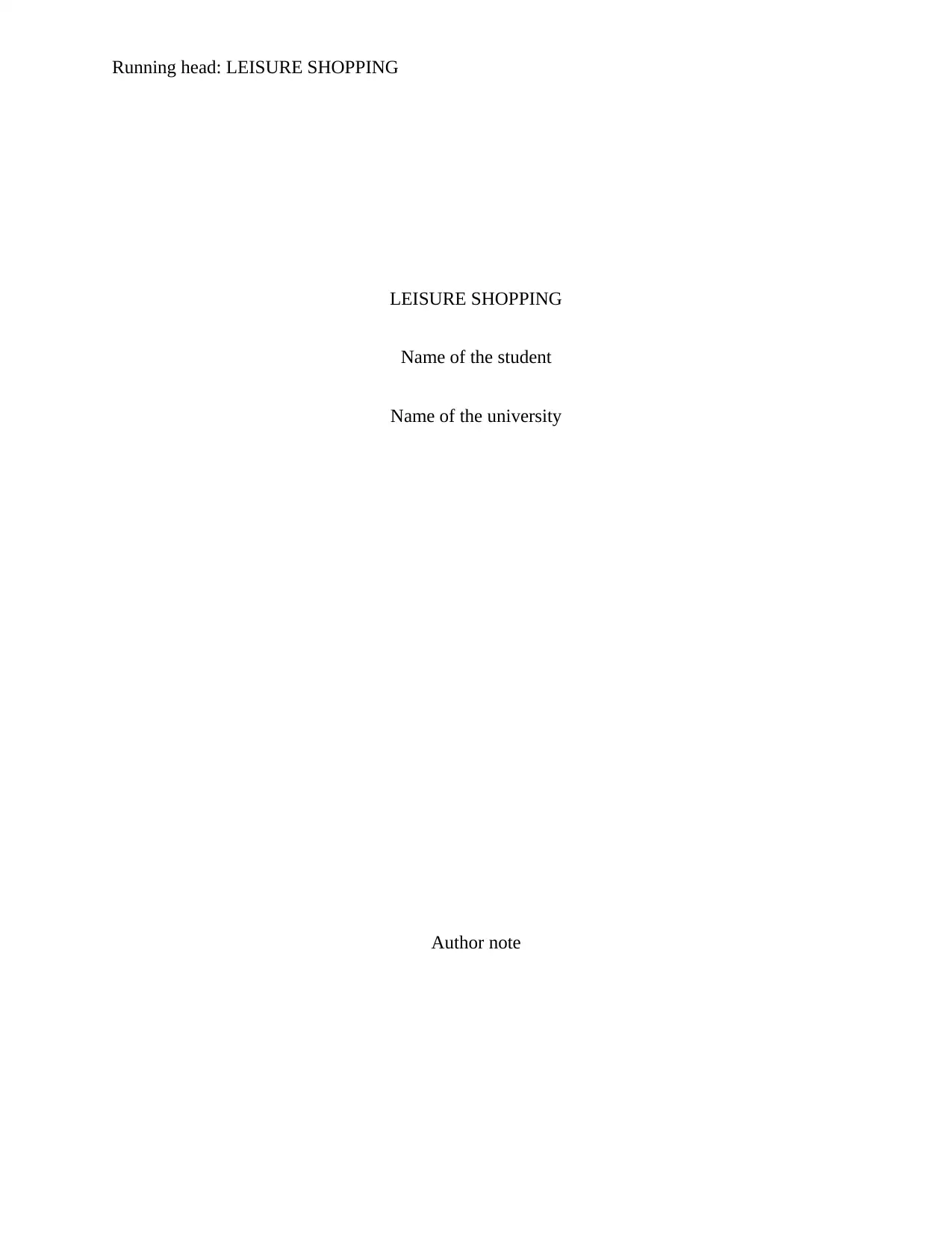
Running head: LEISURE SHOPPING
LEISURE SHOPPING
Name of the student
Name of the university
Author note
LEISURE SHOPPING
Name of the student
Name of the university
Author note
Paraphrase This Document
Need a fresh take? Get an instant paraphrase of this document with our AI Paraphraser
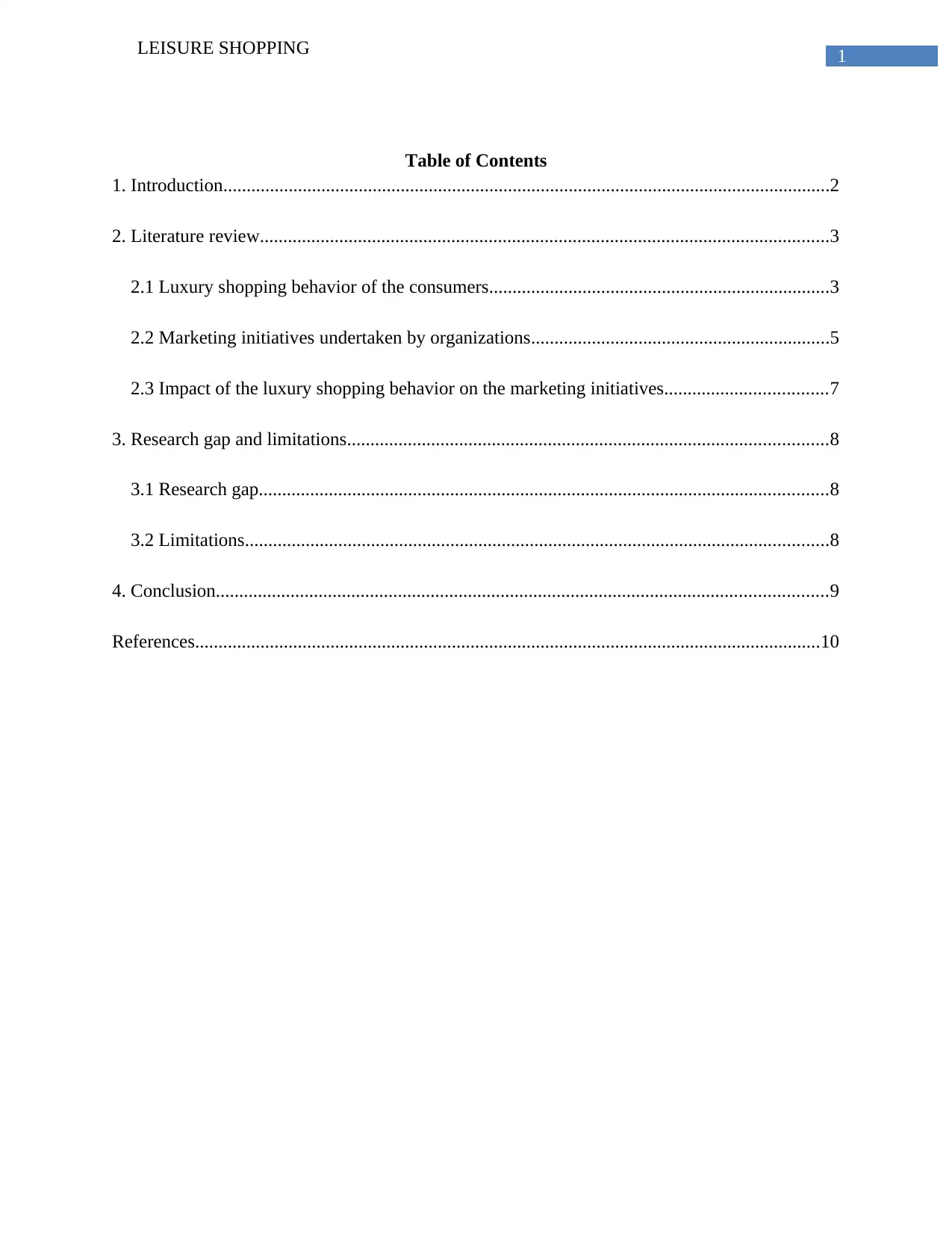
1LEISURE SHOPPING
Table of Contents
1. Introduction..................................................................................................................................2
2. Literature review..........................................................................................................................3
2.1 Luxury shopping behavior of the consumers.........................................................................3
2.2 Marketing initiatives undertaken by organizations................................................................5
2.3 Impact of the luxury shopping behavior on the marketing initiatives...................................7
3. Research gap and limitations.......................................................................................................8
3.1 Research gap..........................................................................................................................8
3.2 Limitations.............................................................................................................................8
4. Conclusion...................................................................................................................................9
References......................................................................................................................................10
Table of Contents
1. Introduction..................................................................................................................................2
2. Literature review..........................................................................................................................3
2.1 Luxury shopping behavior of the consumers.........................................................................3
2.2 Marketing initiatives undertaken by organizations................................................................5
2.3 Impact of the luxury shopping behavior on the marketing initiatives...................................7
3. Research gap and limitations.......................................................................................................8
3.1 Research gap..........................................................................................................................8
3.2 Limitations.............................................................................................................................8
4. Conclusion...................................................................................................................................9
References......................................................................................................................................10
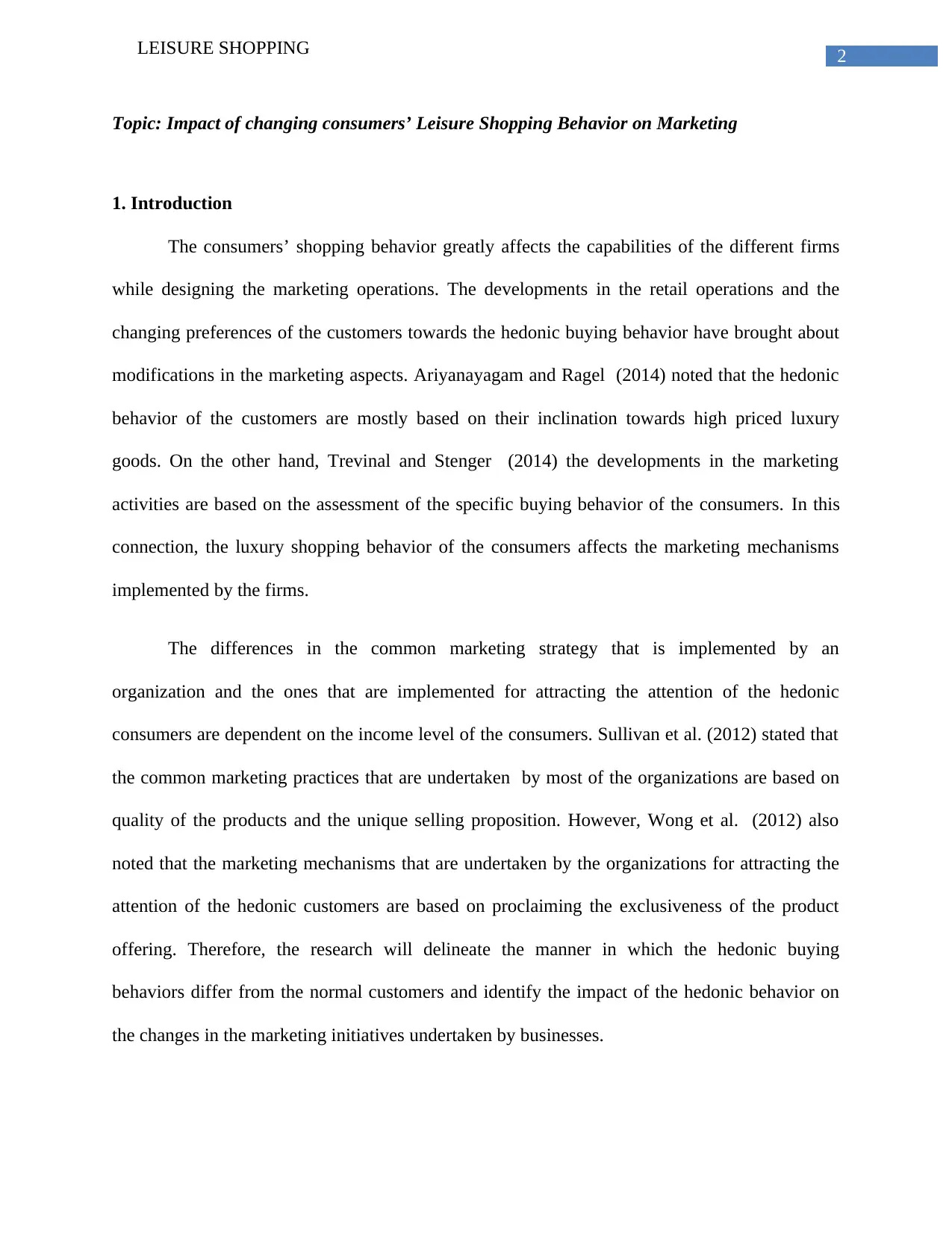
2LEISURE SHOPPING
Topic: Impact of changing consumers’ Leisure Shopping Behavior on Marketing
1. Introduction
The consumers’ shopping behavior greatly affects the capabilities of the different firms
while designing the marketing operations. The developments in the retail operations and the
changing preferences of the customers towards the hedonic buying behavior have brought about
modifications in the marketing aspects. Ariyanayagam and Ragel (2014) noted that the hedonic
behavior of the customers are mostly based on their inclination towards high priced luxury
goods. On the other hand, Trevinal and Stenger (2014) the developments in the marketing
activities are based on the assessment of the specific buying behavior of the consumers. In this
connection, the luxury shopping behavior of the consumers affects the marketing mechanisms
implemented by the firms.
The differences in the common marketing strategy that is implemented by an
organization and the ones that are implemented for attracting the attention of the hedonic
consumers are dependent on the income level of the consumers. Sullivan et al. (2012) stated that
the common marketing practices that are undertaken by most of the organizations are based on
quality of the products and the unique selling proposition. However, Wong et al. (2012) also
noted that the marketing mechanisms that are undertaken by the organizations for attracting the
attention of the hedonic customers are based on proclaiming the exclusiveness of the product
offering. Therefore, the research will delineate the manner in which the hedonic buying
behaviors differ from the normal customers and identify the impact of the hedonic behavior on
the changes in the marketing initiatives undertaken by businesses.
Topic: Impact of changing consumers’ Leisure Shopping Behavior on Marketing
1. Introduction
The consumers’ shopping behavior greatly affects the capabilities of the different firms
while designing the marketing operations. The developments in the retail operations and the
changing preferences of the customers towards the hedonic buying behavior have brought about
modifications in the marketing aspects. Ariyanayagam and Ragel (2014) noted that the hedonic
behavior of the customers are mostly based on their inclination towards high priced luxury
goods. On the other hand, Trevinal and Stenger (2014) the developments in the marketing
activities are based on the assessment of the specific buying behavior of the consumers. In this
connection, the luxury shopping behavior of the consumers affects the marketing mechanisms
implemented by the firms.
The differences in the common marketing strategy that is implemented by an
organization and the ones that are implemented for attracting the attention of the hedonic
consumers are dependent on the income level of the consumers. Sullivan et al. (2012) stated that
the common marketing practices that are undertaken by most of the organizations are based on
quality of the products and the unique selling proposition. However, Wong et al. (2012) also
noted that the marketing mechanisms that are undertaken by the organizations for attracting the
attention of the hedonic customers are based on proclaiming the exclusiveness of the product
offering. Therefore, the research will delineate the manner in which the hedonic buying
behaviors differ from the normal customers and identify the impact of the hedonic behavior on
the changes in the marketing initiatives undertaken by businesses.
⊘ This is a preview!⊘
Do you want full access?
Subscribe today to unlock all pages.

Trusted by 1+ million students worldwide
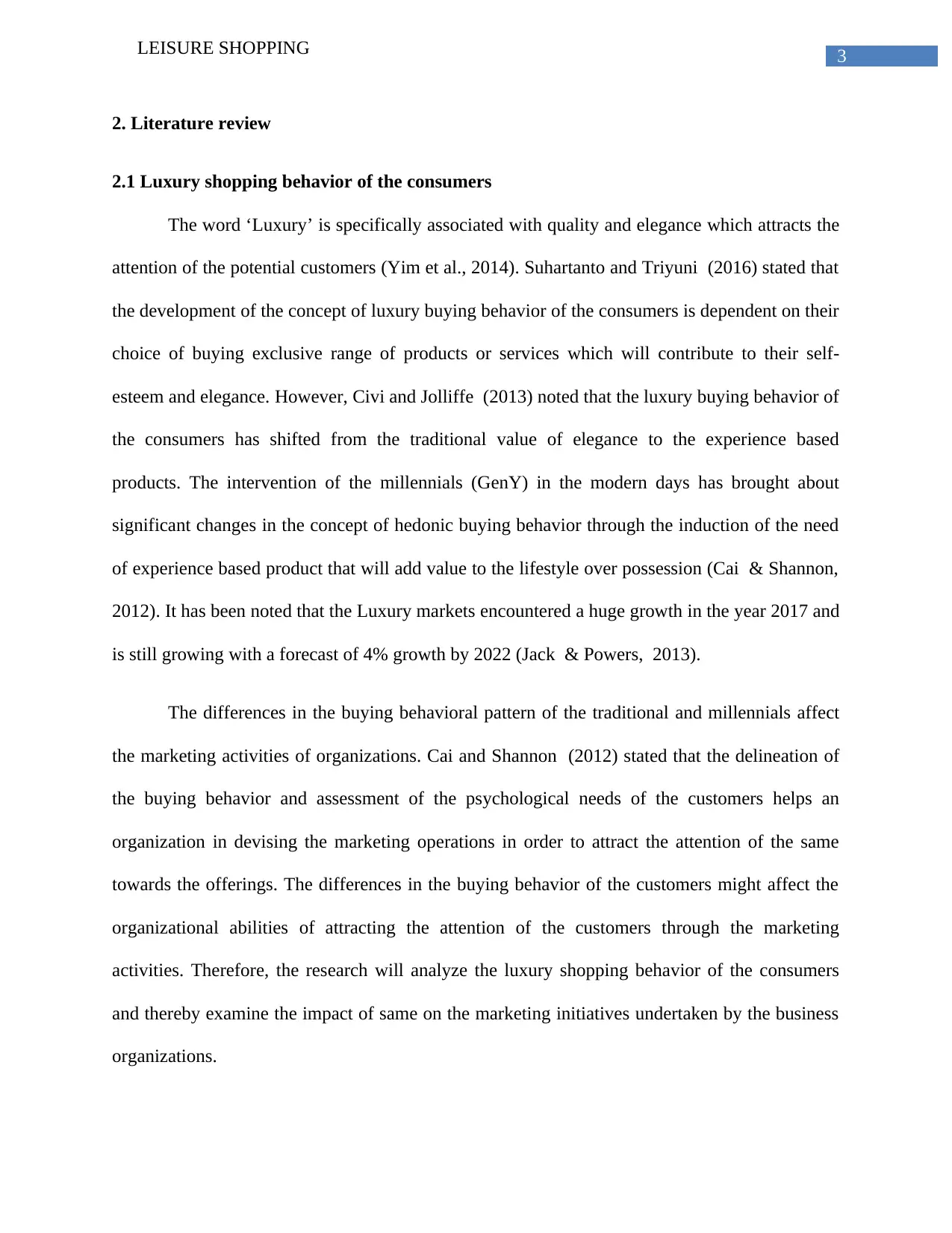
3LEISURE SHOPPING
2. Literature review
2.1 Luxury shopping behavior of the consumers
The word ‘Luxury’ is specifically associated with quality and elegance which attracts the
attention of the potential customers (Yim et al., 2014). Suhartanto and Triyuni (2016) stated that
the development of the concept of luxury buying behavior of the consumers is dependent on their
choice of buying exclusive range of products or services which will contribute to their self-
esteem and elegance. However, Civi and Jolliffe (2013) noted that the luxury buying behavior of
the consumers has shifted from the traditional value of elegance to the experience based
products. The intervention of the millennials (GenY) in the modern days has brought about
significant changes in the concept of hedonic buying behavior through the induction of the need
of experience based product that will add value to the lifestyle over possession (Cai & Shannon,
2012). It has been noted that the Luxury markets encountered a huge growth in the year 2017 and
is still growing with a forecast of 4% growth by 2022 (Jack & Powers, 2013).
The differences in the buying behavioral pattern of the traditional and millennials affect
the marketing activities of organizations. Cai and Shannon (2012) stated that the delineation of
the buying behavior and assessment of the psychological needs of the customers helps an
organization in devising the marketing operations in order to attract the attention of the same
towards the offerings. The differences in the buying behavior of the customers might affect the
organizational abilities of attracting the attention of the customers through the marketing
activities. Therefore, the research will analyze the luxury shopping behavior of the consumers
and thereby examine the impact of same on the marketing initiatives undertaken by the business
organizations.
2. Literature review
2.1 Luxury shopping behavior of the consumers
The word ‘Luxury’ is specifically associated with quality and elegance which attracts the
attention of the potential customers (Yim et al., 2014). Suhartanto and Triyuni (2016) stated that
the development of the concept of luxury buying behavior of the consumers is dependent on their
choice of buying exclusive range of products or services which will contribute to their self-
esteem and elegance. However, Civi and Jolliffe (2013) noted that the luxury buying behavior of
the consumers has shifted from the traditional value of elegance to the experience based
products. The intervention of the millennials (GenY) in the modern days has brought about
significant changes in the concept of hedonic buying behavior through the induction of the need
of experience based product that will add value to the lifestyle over possession (Cai & Shannon,
2012). It has been noted that the Luxury markets encountered a huge growth in the year 2017 and
is still growing with a forecast of 4% growth by 2022 (Jack & Powers, 2013).
The differences in the buying behavioral pattern of the traditional and millennials affect
the marketing activities of organizations. Cai and Shannon (2012) stated that the delineation of
the buying behavior and assessment of the psychological needs of the customers helps an
organization in devising the marketing operations in order to attract the attention of the same
towards the offerings. The differences in the buying behavior of the customers might affect the
organizational abilities of attracting the attention of the customers through the marketing
activities. Therefore, the research will analyze the luxury shopping behavior of the consumers
and thereby examine the impact of same on the marketing initiatives undertaken by the business
organizations.
Paraphrase This Document
Need a fresh take? Get an instant paraphrase of this document with our AI Paraphraser
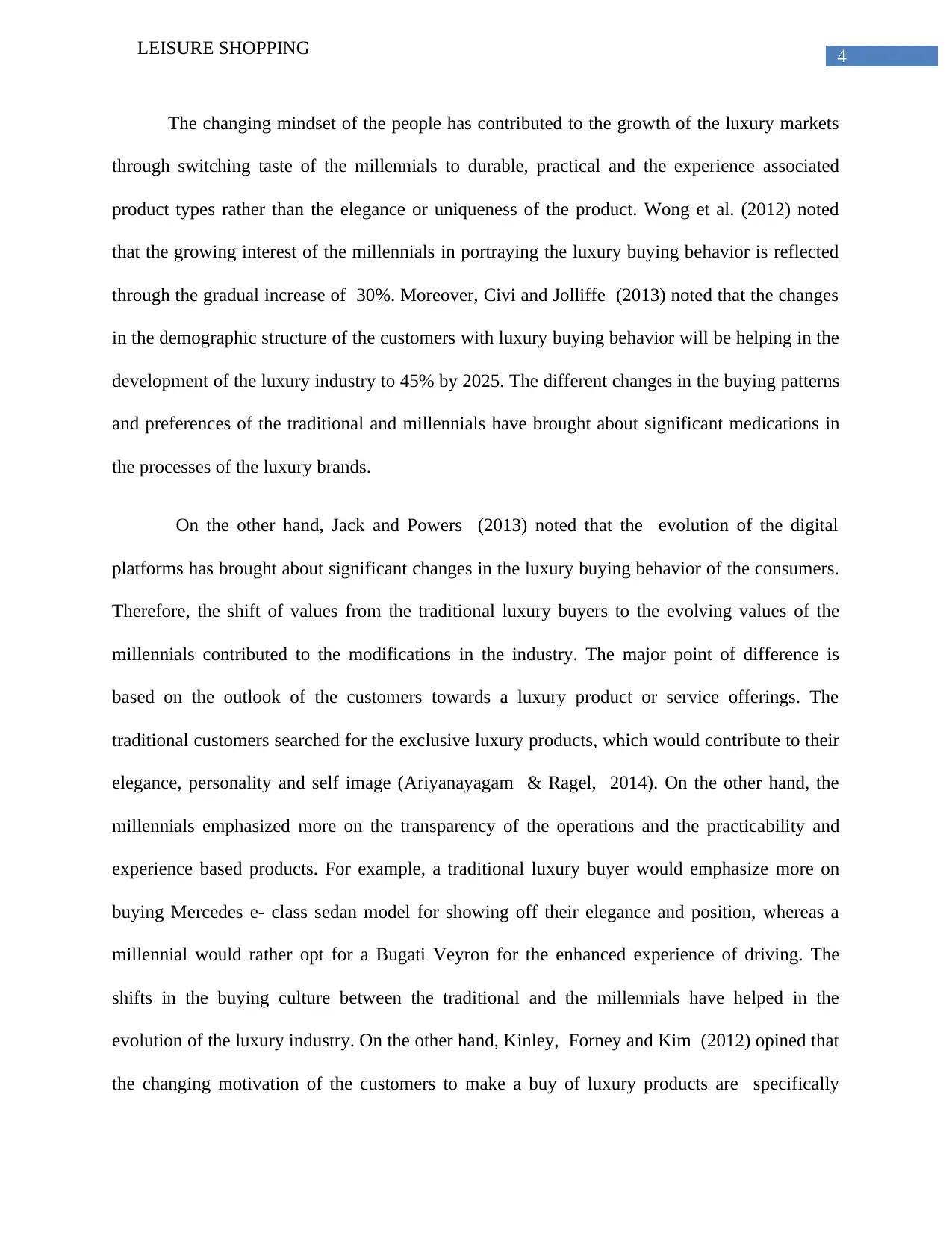
4LEISURE SHOPPING
The changing mindset of the people has contributed to the growth of the luxury markets
through switching taste of the millennials to durable, practical and the experience associated
product types rather than the elegance or uniqueness of the product. Wong et al. (2012) noted
that the growing interest of the millennials in portraying the luxury buying behavior is reflected
through the gradual increase of 30%. Moreover, Civi and Jolliffe (2013) noted that the changes
in the demographic structure of the customers with luxury buying behavior will be helping in the
development of the luxury industry to 45% by 2025. The different changes in the buying patterns
and preferences of the traditional and millennials have brought about significant medications in
the processes of the luxury brands.
On the other hand, Jack and Powers (2013) noted that the evolution of the digital
platforms has brought about significant changes in the luxury buying behavior of the consumers.
Therefore, the shift of values from the traditional luxury buyers to the evolving values of the
millennials contributed to the modifications in the industry. The major point of difference is
based on the outlook of the customers towards a luxury product or service offerings. The
traditional customers searched for the exclusive luxury products, which would contribute to their
elegance, personality and self image (Ariyanayagam & Ragel, 2014). On the other hand, the
millennials emphasized more on the transparency of the operations and the practicability and
experience based products. For example, a traditional luxury buyer would emphasize more on
buying Mercedes e- class sedan model for showing off their elegance and position, whereas a
millennial would rather opt for a Bugati Veyron for the enhanced experience of driving. The
shifts in the buying culture between the traditional and the millennials have helped in the
evolution of the luxury industry. On the other hand, Kinley, Forney and Kim (2012) opined that
the changing motivation of the customers to make a buy of luxury products are specifically
The changing mindset of the people has contributed to the growth of the luxury markets
through switching taste of the millennials to durable, practical and the experience associated
product types rather than the elegance or uniqueness of the product. Wong et al. (2012) noted
that the growing interest of the millennials in portraying the luxury buying behavior is reflected
through the gradual increase of 30%. Moreover, Civi and Jolliffe (2013) noted that the changes
in the demographic structure of the customers with luxury buying behavior will be helping in the
development of the luxury industry to 45% by 2025. The different changes in the buying patterns
and preferences of the traditional and millennials have brought about significant medications in
the processes of the luxury brands.
On the other hand, Jack and Powers (2013) noted that the evolution of the digital
platforms has brought about significant changes in the luxury buying behavior of the consumers.
Therefore, the shift of values from the traditional luxury buyers to the evolving values of the
millennials contributed to the modifications in the industry. The major point of difference is
based on the outlook of the customers towards a luxury product or service offerings. The
traditional customers searched for the exclusive luxury products, which would contribute to their
elegance, personality and self image (Ariyanayagam & Ragel, 2014). On the other hand, the
millennials emphasized more on the transparency of the operations and the practicability and
experience based products. For example, a traditional luxury buyer would emphasize more on
buying Mercedes e- class sedan model for showing off their elegance and position, whereas a
millennial would rather opt for a Bugati Veyron for the enhanced experience of driving. The
shifts in the buying culture between the traditional and the millennials have helped in the
evolution of the luxury industry. On the other hand, Kinley, Forney and Kim (2012) opined that
the changing motivation of the customers to make a buy of luxury products are specifically
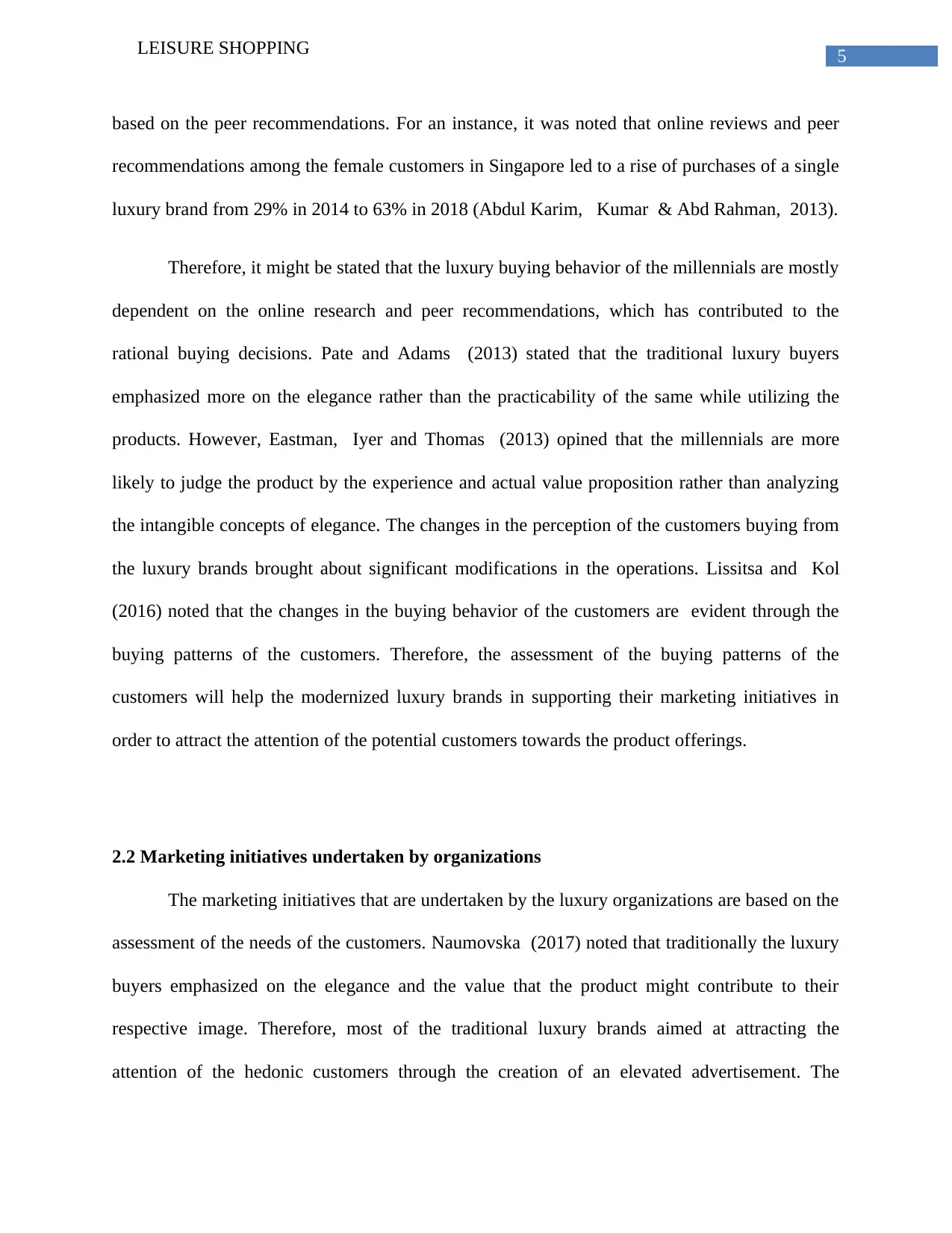
5LEISURE SHOPPING
based on the peer recommendations. For an instance, it was noted that online reviews and peer
recommendations among the female customers in Singapore led to a rise of purchases of a single
luxury brand from 29% in 2014 to 63% in 2018 (Abdul Karim, Kumar & Abd Rahman, 2013).
Therefore, it might be stated that the luxury buying behavior of the millennials are mostly
dependent on the online research and peer recommendations, which has contributed to the
rational buying decisions. Pate and Adams (2013) stated that the traditional luxury buyers
emphasized more on the elegance rather than the practicability of the same while utilizing the
products. However, Eastman, Iyer and Thomas (2013) opined that the millennials are more
likely to judge the product by the experience and actual value proposition rather than analyzing
the intangible concepts of elegance. The changes in the perception of the customers buying from
the luxury brands brought about significant modifications in the operations. Lissitsa and Kol
(2016) noted that the changes in the buying behavior of the customers are evident through the
buying patterns of the customers. Therefore, the assessment of the buying patterns of the
customers will help the modernized luxury brands in supporting their marketing initiatives in
order to attract the attention of the potential customers towards the product offerings.
2.2 Marketing initiatives undertaken by organizations
The marketing initiatives that are undertaken by the luxury organizations are based on the
assessment of the needs of the customers. Naumovska (2017) noted that traditionally the luxury
buyers emphasized on the elegance and the value that the product might contribute to their
respective image. Therefore, most of the traditional luxury brands aimed at attracting the
attention of the hedonic customers through the creation of an elevated advertisement. The
based on the peer recommendations. For an instance, it was noted that online reviews and peer
recommendations among the female customers in Singapore led to a rise of purchases of a single
luxury brand from 29% in 2014 to 63% in 2018 (Abdul Karim, Kumar & Abd Rahman, 2013).
Therefore, it might be stated that the luxury buying behavior of the millennials are mostly
dependent on the online research and peer recommendations, which has contributed to the
rational buying decisions. Pate and Adams (2013) stated that the traditional luxury buyers
emphasized more on the elegance rather than the practicability of the same while utilizing the
products. However, Eastman, Iyer and Thomas (2013) opined that the millennials are more
likely to judge the product by the experience and actual value proposition rather than analyzing
the intangible concepts of elegance. The changes in the perception of the customers buying from
the luxury brands brought about significant modifications in the operations. Lissitsa and Kol
(2016) noted that the changes in the buying behavior of the customers are evident through the
buying patterns of the customers. Therefore, the assessment of the buying patterns of the
customers will help the modernized luxury brands in supporting their marketing initiatives in
order to attract the attention of the potential customers towards the product offerings.
2.2 Marketing initiatives undertaken by organizations
The marketing initiatives that are undertaken by the luxury organizations are based on the
assessment of the needs of the customers. Naumovska (2017) noted that traditionally the luxury
buyers emphasized on the elegance and the value that the product might contribute to their
respective image. Therefore, most of the traditional luxury brands aimed at attracting the
attention of the hedonic customers through the creation of an elevated advertisement. The
⊘ This is a preview!⊘
Do you want full access?
Subscribe today to unlock all pages.

Trusted by 1+ million students worldwide
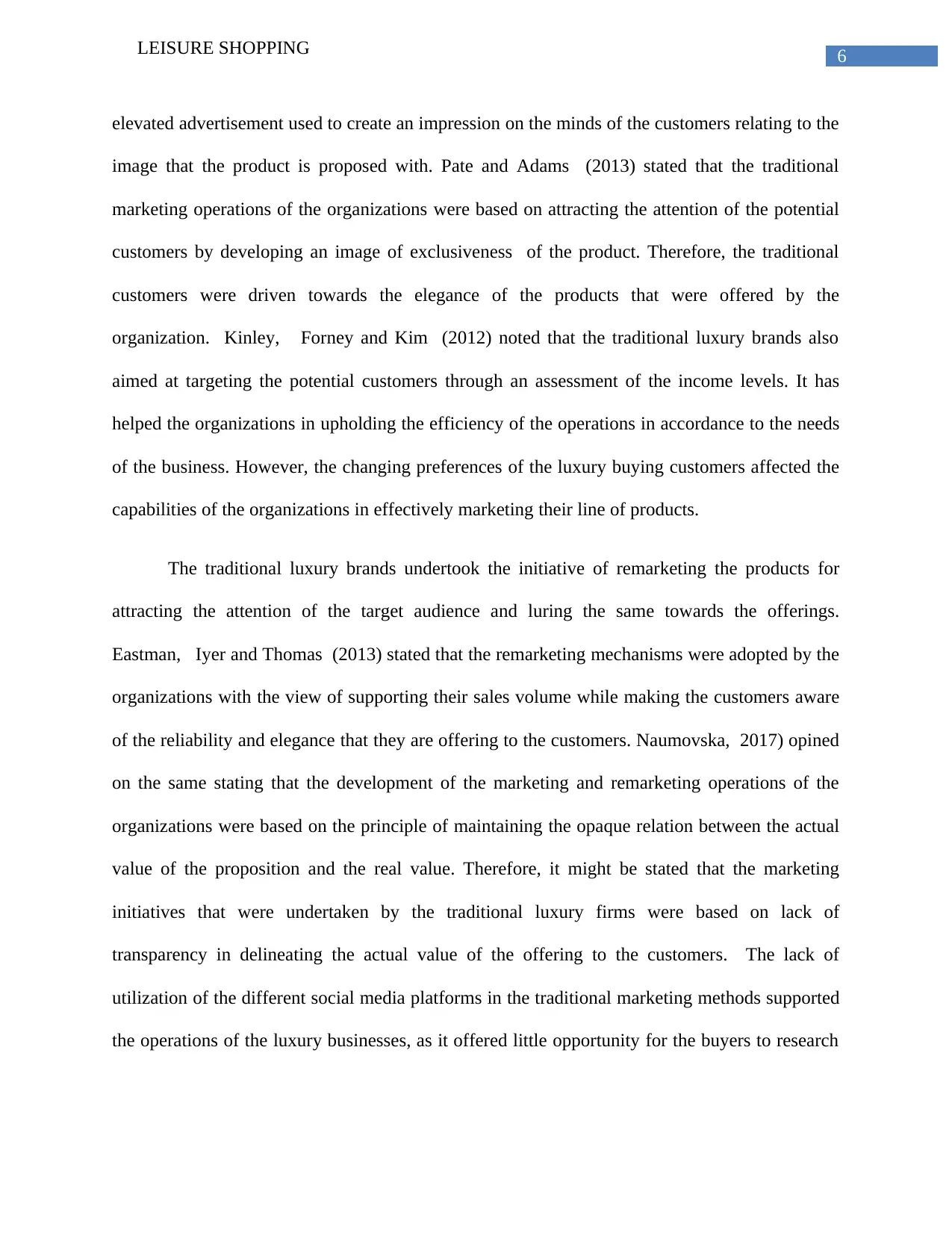
6LEISURE SHOPPING
elevated advertisement used to create an impression on the minds of the customers relating to the
image that the product is proposed with. Pate and Adams (2013) stated that the traditional
marketing operations of the organizations were based on attracting the attention of the potential
customers by developing an image of exclusiveness of the product. Therefore, the traditional
customers were driven towards the elegance of the products that were offered by the
organization. Kinley, Forney and Kim (2012) noted that the traditional luxury brands also
aimed at targeting the potential customers through an assessment of the income levels. It has
helped the organizations in upholding the efficiency of the operations in accordance to the needs
of the business. However, the changing preferences of the luxury buying customers affected the
capabilities of the organizations in effectively marketing their line of products.
The traditional luxury brands undertook the initiative of remarketing the products for
attracting the attention of the target audience and luring the same towards the offerings.
Eastman, Iyer and Thomas (2013) stated that the remarketing mechanisms were adopted by the
organizations with the view of supporting their sales volume while making the customers aware
of the reliability and elegance that they are offering to the customers. Naumovska, 2017) opined
on the same stating that the development of the marketing and remarketing operations of the
organizations were based on the principle of maintaining the opaque relation between the actual
value of the proposition and the real value. Therefore, it might be stated that the marketing
initiatives that were undertaken by the traditional luxury firms were based on lack of
transparency in delineating the actual value of the offering to the customers. The lack of
utilization of the different social media platforms in the traditional marketing methods supported
the operations of the luxury businesses, as it offered little opportunity for the buyers to research
elevated advertisement used to create an impression on the minds of the customers relating to the
image that the product is proposed with. Pate and Adams (2013) stated that the traditional
marketing operations of the organizations were based on attracting the attention of the potential
customers by developing an image of exclusiveness of the product. Therefore, the traditional
customers were driven towards the elegance of the products that were offered by the
organization. Kinley, Forney and Kim (2012) noted that the traditional luxury brands also
aimed at targeting the potential customers through an assessment of the income levels. It has
helped the organizations in upholding the efficiency of the operations in accordance to the needs
of the business. However, the changing preferences of the luxury buying customers affected the
capabilities of the organizations in effectively marketing their line of products.
The traditional luxury brands undertook the initiative of remarketing the products for
attracting the attention of the target audience and luring the same towards the offerings.
Eastman, Iyer and Thomas (2013) stated that the remarketing mechanisms were adopted by the
organizations with the view of supporting their sales volume while making the customers aware
of the reliability and elegance that they are offering to the customers. Naumovska, 2017) opined
on the same stating that the development of the marketing and remarketing operations of the
organizations were based on the principle of maintaining the opaque relation between the actual
value of the proposition and the real value. Therefore, it might be stated that the marketing
initiatives that were undertaken by the traditional luxury firms were based on lack of
transparency in delineating the actual value of the offering to the customers. The lack of
utilization of the different social media platforms in the traditional marketing methods supported
the operations of the luxury businesses, as it offered little opportunity for the buyers to research
Paraphrase This Document
Need a fresh take? Get an instant paraphrase of this document with our AI Paraphraser
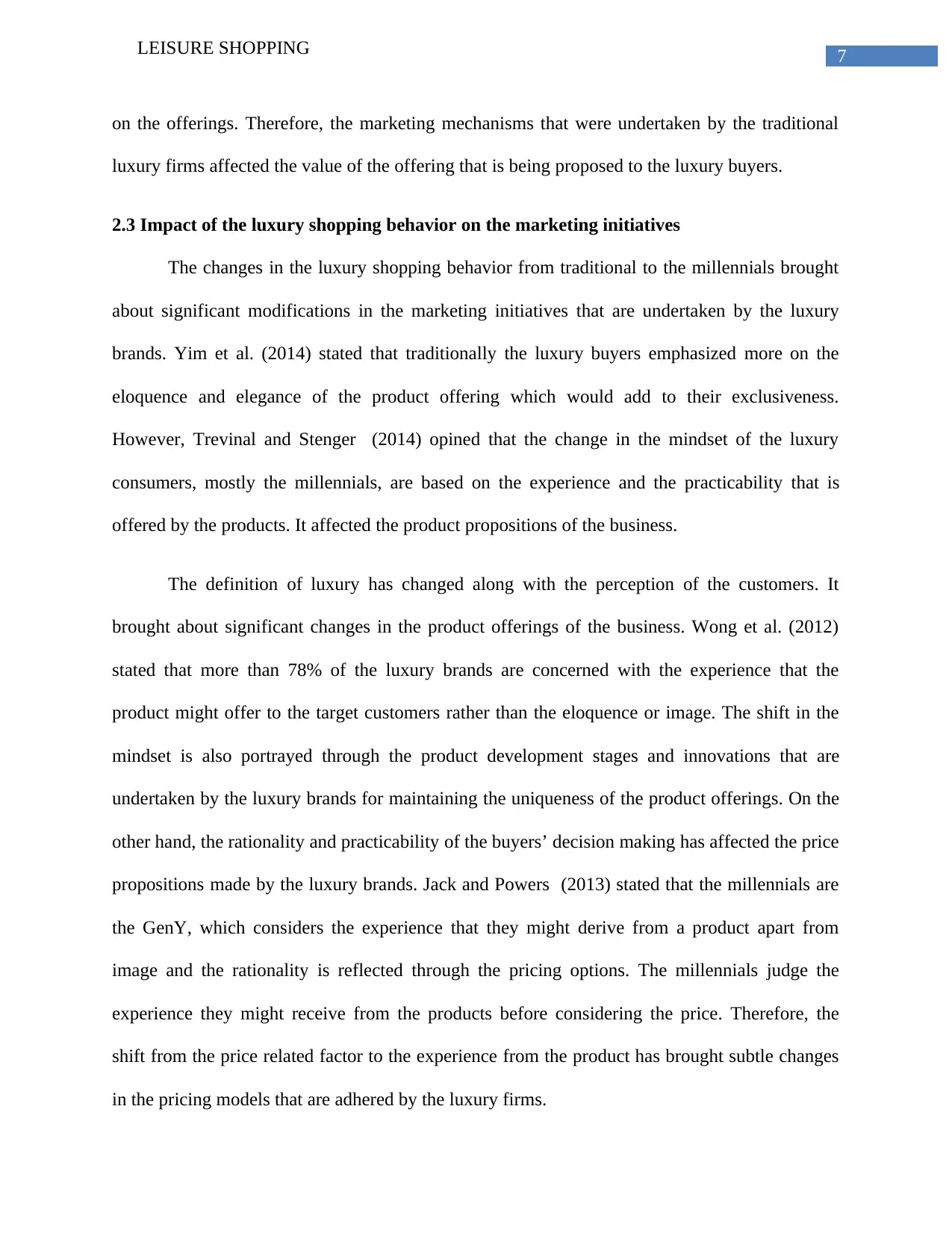
7LEISURE SHOPPING
on the offerings. Therefore, the marketing mechanisms that were undertaken by the traditional
luxury firms affected the value of the offering that is being proposed to the luxury buyers.
2.3 Impact of the luxury shopping behavior on the marketing initiatives
The changes in the luxury shopping behavior from traditional to the millennials brought
about significant modifications in the marketing initiatives that are undertaken by the luxury
brands. Yim et al. (2014) stated that traditionally the luxury buyers emphasized more on the
eloquence and elegance of the product offering which would add to their exclusiveness.
However, Trevinal and Stenger (2014) opined that the change in the mindset of the luxury
consumers, mostly the millennials, are based on the experience and the practicability that is
offered by the products. It affected the product propositions of the business.
The definition of luxury has changed along with the perception of the customers. It
brought about significant changes in the product offerings of the business. Wong et al. (2012)
stated that more than 78% of the luxury brands are concerned with the experience that the
product might offer to the target customers rather than the eloquence or image. The shift in the
mindset is also portrayed through the product development stages and innovations that are
undertaken by the luxury brands for maintaining the uniqueness of the product offerings. On the
other hand, the rationality and practicability of the buyers’ decision making has affected the price
propositions made by the luxury brands. Jack and Powers (2013) stated that the millennials are
the GenY, which considers the experience that they might derive from a product apart from
image and the rationality is reflected through the pricing options. The millennials judge the
experience they might receive from the products before considering the price. Therefore, the
shift from the price related factor to the experience from the product has brought subtle changes
in the pricing models that are adhered by the luxury firms.
on the offerings. Therefore, the marketing mechanisms that were undertaken by the traditional
luxury firms affected the value of the offering that is being proposed to the luxury buyers.
2.3 Impact of the luxury shopping behavior on the marketing initiatives
The changes in the luxury shopping behavior from traditional to the millennials brought
about significant modifications in the marketing initiatives that are undertaken by the luxury
brands. Yim et al. (2014) stated that traditionally the luxury buyers emphasized more on the
eloquence and elegance of the product offering which would add to their exclusiveness.
However, Trevinal and Stenger (2014) opined that the change in the mindset of the luxury
consumers, mostly the millennials, are based on the experience and the practicability that is
offered by the products. It affected the product propositions of the business.
The definition of luxury has changed along with the perception of the customers. It
brought about significant changes in the product offerings of the business. Wong et al. (2012)
stated that more than 78% of the luxury brands are concerned with the experience that the
product might offer to the target customers rather than the eloquence or image. The shift in the
mindset is also portrayed through the product development stages and innovations that are
undertaken by the luxury brands for maintaining the uniqueness of the product offerings. On the
other hand, the rationality and practicability of the buyers’ decision making has affected the price
propositions made by the luxury brands. Jack and Powers (2013) stated that the millennials are
the GenY, which considers the experience that they might derive from a product apart from
image and the rationality is reflected through the pricing options. The millennials judge the
experience they might receive from the products before considering the price. Therefore, the
shift from the price related factor to the experience from the product has brought subtle changes
in the pricing models that are adhered by the luxury firms.
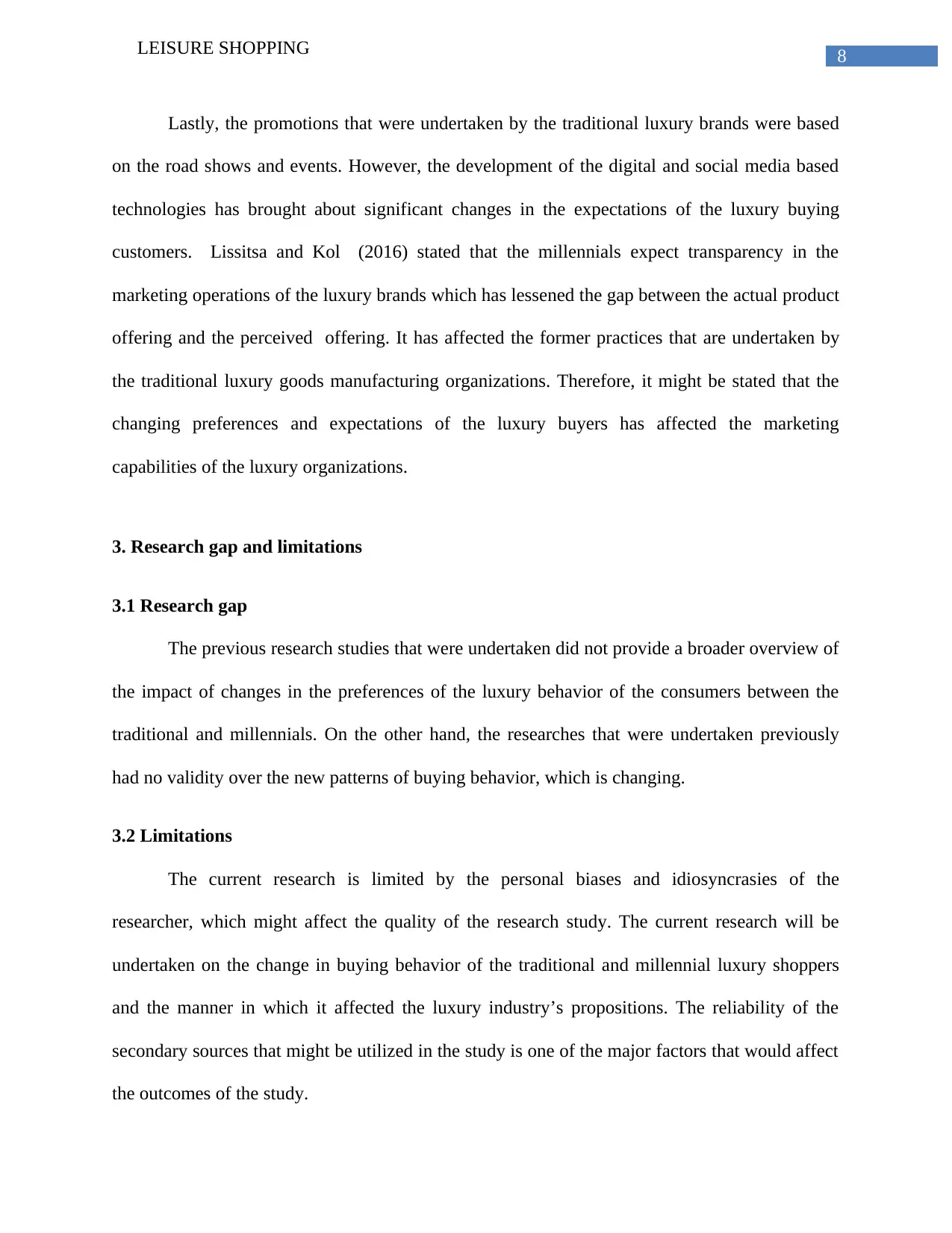
8LEISURE SHOPPING
Lastly, the promotions that were undertaken by the traditional luxury brands were based
on the road shows and events. However, the development of the digital and social media based
technologies has brought about significant changes in the expectations of the luxury buying
customers. Lissitsa and Kol (2016) stated that the millennials expect transparency in the
marketing operations of the luxury brands which has lessened the gap between the actual product
offering and the perceived offering. It has affected the former practices that are undertaken by
the traditional luxury goods manufacturing organizations. Therefore, it might be stated that the
changing preferences and expectations of the luxury buyers has affected the marketing
capabilities of the luxury organizations.
3. Research gap and limitations
3.1 Research gap
The previous research studies that were undertaken did not provide a broader overview of
the impact of changes in the preferences of the luxury behavior of the consumers between the
traditional and millennials. On the other hand, the researches that were undertaken previously
had no validity over the new patterns of buying behavior, which is changing.
3.2 Limitations
The current research is limited by the personal biases and idiosyncrasies of the
researcher, which might affect the quality of the research study. The current research will be
undertaken on the change in buying behavior of the traditional and millennial luxury shoppers
and the manner in which it affected the luxury industry’s propositions. The reliability of the
secondary sources that might be utilized in the study is one of the major factors that would affect
the outcomes of the study.
Lastly, the promotions that were undertaken by the traditional luxury brands were based
on the road shows and events. However, the development of the digital and social media based
technologies has brought about significant changes in the expectations of the luxury buying
customers. Lissitsa and Kol (2016) stated that the millennials expect transparency in the
marketing operations of the luxury brands which has lessened the gap between the actual product
offering and the perceived offering. It has affected the former practices that are undertaken by
the traditional luxury goods manufacturing organizations. Therefore, it might be stated that the
changing preferences and expectations of the luxury buyers has affected the marketing
capabilities of the luxury organizations.
3. Research gap and limitations
3.1 Research gap
The previous research studies that were undertaken did not provide a broader overview of
the impact of changes in the preferences of the luxury behavior of the consumers between the
traditional and millennials. On the other hand, the researches that were undertaken previously
had no validity over the new patterns of buying behavior, which is changing.
3.2 Limitations
The current research is limited by the personal biases and idiosyncrasies of the
researcher, which might affect the quality of the research study. The current research will be
undertaken on the change in buying behavior of the traditional and millennial luxury shoppers
and the manner in which it affected the luxury industry’s propositions. The reliability of the
secondary sources that might be utilized in the study is one of the major factors that would affect
the outcomes of the study.
⊘ This is a preview!⊘
Do you want full access?
Subscribe today to unlock all pages.

Trusted by 1+ million students worldwide
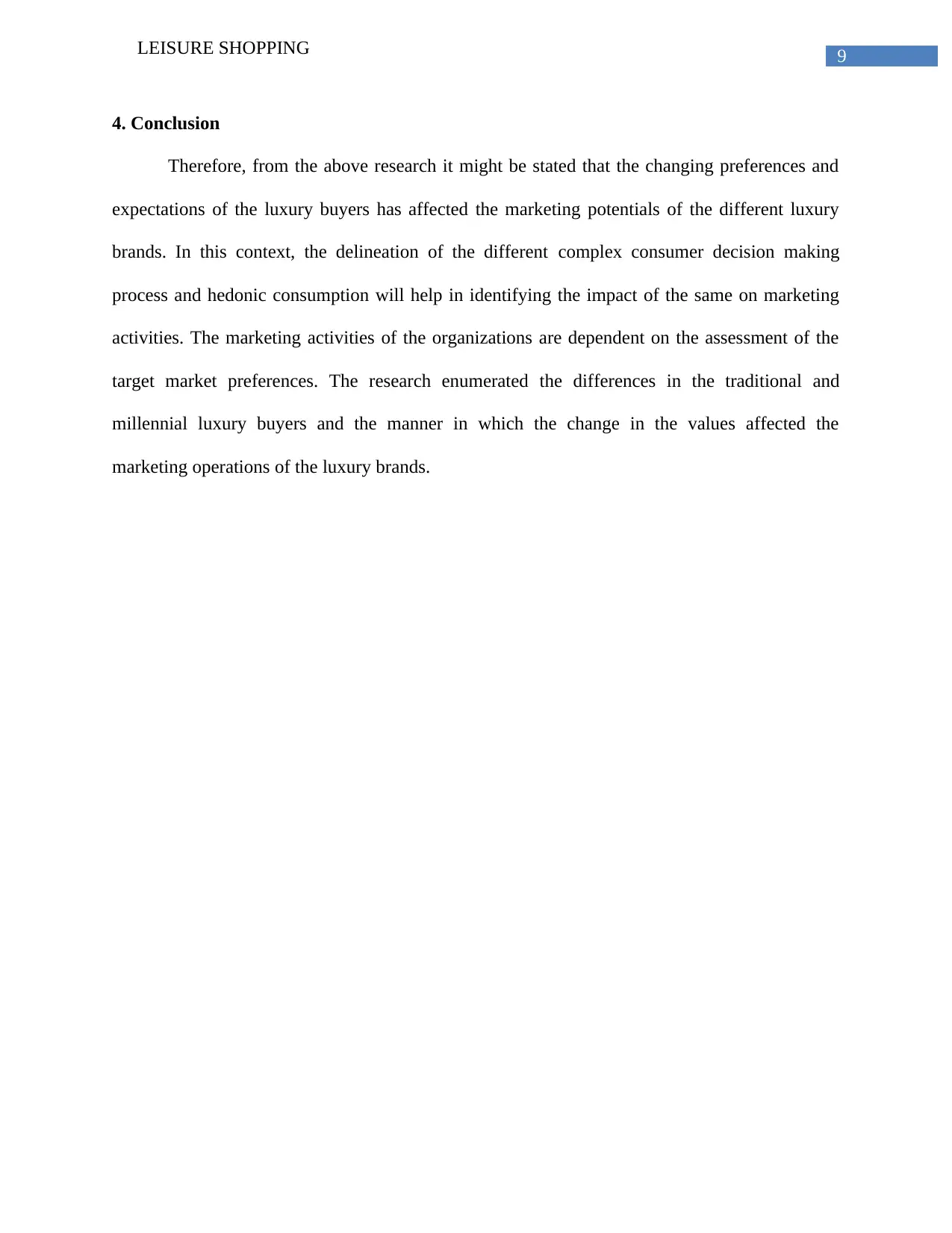
9LEISURE SHOPPING
4. Conclusion
Therefore, from the above research it might be stated that the changing preferences and
expectations of the luxury buyers has affected the marketing potentials of the different luxury
brands. In this context, the delineation of the different complex consumer decision making
process and hedonic consumption will help in identifying the impact of the same on marketing
activities. The marketing activities of the organizations are dependent on the assessment of the
target market preferences. The research enumerated the differences in the traditional and
millennial luxury buyers and the manner in which the change in the values affected the
marketing operations of the luxury brands.
4. Conclusion
Therefore, from the above research it might be stated that the changing preferences and
expectations of the luxury buyers has affected the marketing potentials of the different luxury
brands. In this context, the delineation of the different complex consumer decision making
process and hedonic consumption will help in identifying the impact of the same on marketing
activities. The marketing activities of the organizations are dependent on the assessment of the
target market preferences. The research enumerated the differences in the traditional and
millennial luxury buyers and the manner in which the change in the values affected the
marketing operations of the luxury brands.
Paraphrase This Document
Need a fresh take? Get an instant paraphrase of this document with our AI Paraphraser
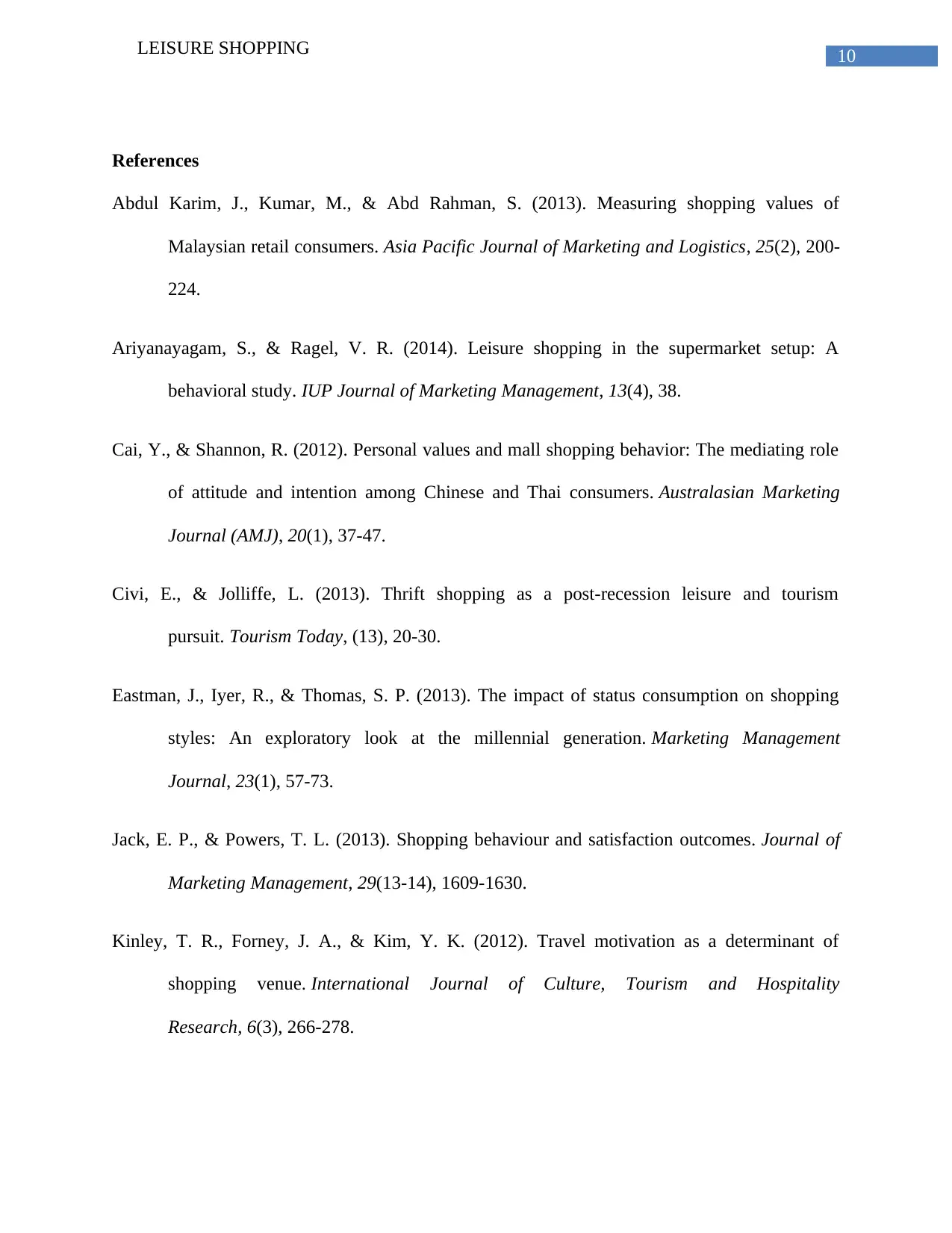
10LEISURE SHOPPING
References
Abdul Karim, J., Kumar, M., & Abd Rahman, S. (2013). Measuring shopping values of
Malaysian retail consumers. Asia Pacific Journal of Marketing and Logistics, 25(2), 200-
224.
Ariyanayagam, S., & Ragel, V. R. (2014). Leisure shopping in the supermarket setup: A
behavioral study. IUP Journal of Marketing Management, 13(4), 38.
Cai, Y., & Shannon, R. (2012). Personal values and mall shopping behavior: The mediating role
of attitude and intention among Chinese and Thai consumers. Australasian Marketing
Journal (AMJ), 20(1), 37-47.
Civi, E., & Jolliffe, L. (2013). Thrift shopping as a post-recession leisure and tourism
pursuit. Tourism Today, (13), 20-30.
Eastman, J., Iyer, R., & Thomas, S. P. (2013). The impact of status consumption on shopping
styles: An exploratory look at the millennial generation. Marketing Management
Journal, 23(1), 57-73.
Jack, E. P., & Powers, T. L. (2013). Shopping behaviour and satisfaction outcomes. Journal of
Marketing Management, 29(13-14), 1609-1630.
Kinley, T. R., Forney, J. A., & Kim, Y. K. (2012). Travel motivation as a determinant of
shopping venue. International Journal of Culture, Tourism and Hospitality
Research, 6(3), 266-278.
References
Abdul Karim, J., Kumar, M., & Abd Rahman, S. (2013). Measuring shopping values of
Malaysian retail consumers. Asia Pacific Journal of Marketing and Logistics, 25(2), 200-
224.
Ariyanayagam, S., & Ragel, V. R. (2014). Leisure shopping in the supermarket setup: A
behavioral study. IUP Journal of Marketing Management, 13(4), 38.
Cai, Y., & Shannon, R. (2012). Personal values and mall shopping behavior: The mediating role
of attitude and intention among Chinese and Thai consumers. Australasian Marketing
Journal (AMJ), 20(1), 37-47.
Civi, E., & Jolliffe, L. (2013). Thrift shopping as a post-recession leisure and tourism
pursuit. Tourism Today, (13), 20-30.
Eastman, J., Iyer, R., & Thomas, S. P. (2013). The impact of status consumption on shopping
styles: An exploratory look at the millennial generation. Marketing Management
Journal, 23(1), 57-73.
Jack, E. P., & Powers, T. L. (2013). Shopping behaviour and satisfaction outcomes. Journal of
Marketing Management, 29(13-14), 1609-1630.
Kinley, T. R., Forney, J. A., & Kim, Y. K. (2012). Travel motivation as a determinant of
shopping venue. International Journal of Culture, Tourism and Hospitality
Research, 6(3), 266-278.
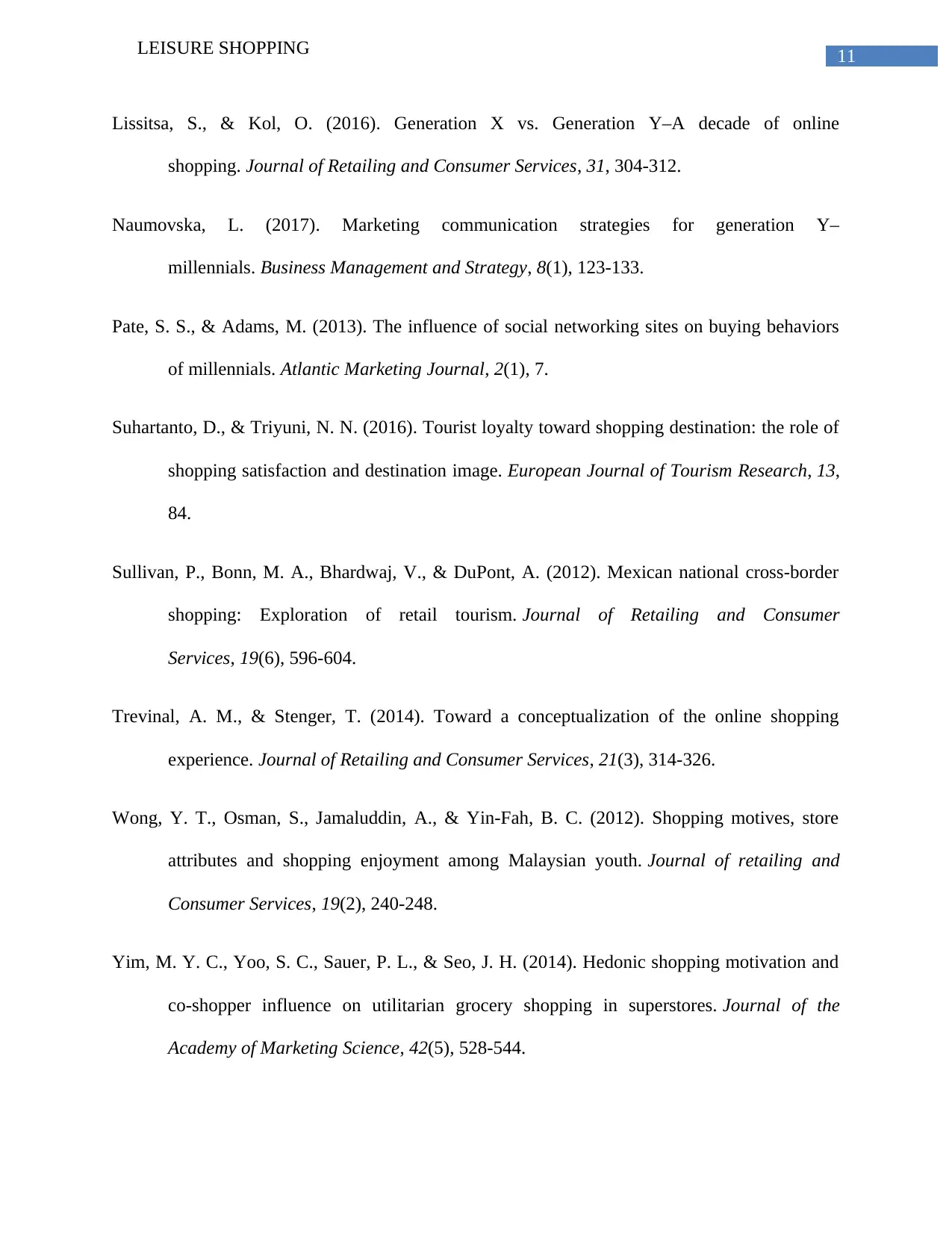
11LEISURE SHOPPING
Lissitsa, S., & Kol, O. (2016). Generation X vs. Generation Y–A decade of online
shopping. Journal of Retailing and Consumer Services, 31, 304-312.
Naumovska, L. (2017). Marketing communication strategies for generation Y–
millennials. Business Management and Strategy, 8(1), 123-133.
Pate, S. S., & Adams, M. (2013). The influence of social networking sites on buying behaviors
of millennials. Atlantic Marketing Journal, 2(1), 7.
Suhartanto, D., & Triyuni, N. N. (2016). Tourist loyalty toward shopping destination: the role of
shopping satisfaction and destination image. European Journal of Tourism Research, 13,
84.
Sullivan, P., Bonn, M. A., Bhardwaj, V., & DuPont, A. (2012). Mexican national cross-border
shopping: Exploration of retail tourism. Journal of Retailing and Consumer
Services, 19(6), 596-604.
Trevinal, A. M., & Stenger, T. (2014). Toward a conceptualization of the online shopping
experience. Journal of Retailing and Consumer Services, 21(3), 314-326.
Wong, Y. T., Osman, S., Jamaluddin, A., & Yin-Fah, B. C. (2012). Shopping motives, store
attributes and shopping enjoyment among Malaysian youth. Journal of retailing and
Consumer Services, 19(2), 240-248.
Yim, M. Y. C., Yoo, S. C., Sauer, P. L., & Seo, J. H. (2014). Hedonic shopping motivation and
co-shopper influence on utilitarian grocery shopping in superstores. Journal of the
Academy of Marketing Science, 42(5), 528-544.
Lissitsa, S., & Kol, O. (2016). Generation X vs. Generation Y–A decade of online
shopping. Journal of Retailing and Consumer Services, 31, 304-312.
Naumovska, L. (2017). Marketing communication strategies for generation Y–
millennials. Business Management and Strategy, 8(1), 123-133.
Pate, S. S., & Adams, M. (2013). The influence of social networking sites on buying behaviors
of millennials. Atlantic Marketing Journal, 2(1), 7.
Suhartanto, D., & Triyuni, N. N. (2016). Tourist loyalty toward shopping destination: the role of
shopping satisfaction and destination image. European Journal of Tourism Research, 13,
84.
Sullivan, P., Bonn, M. A., Bhardwaj, V., & DuPont, A. (2012). Mexican national cross-border
shopping: Exploration of retail tourism. Journal of Retailing and Consumer
Services, 19(6), 596-604.
Trevinal, A. M., & Stenger, T. (2014). Toward a conceptualization of the online shopping
experience. Journal of Retailing and Consumer Services, 21(3), 314-326.
Wong, Y. T., Osman, S., Jamaluddin, A., & Yin-Fah, B. C. (2012). Shopping motives, store
attributes and shopping enjoyment among Malaysian youth. Journal of retailing and
Consumer Services, 19(2), 240-248.
Yim, M. Y. C., Yoo, S. C., Sauer, P. L., & Seo, J. H. (2014). Hedonic shopping motivation and
co-shopper influence on utilitarian grocery shopping in superstores. Journal of the
Academy of Marketing Science, 42(5), 528-544.
⊘ This is a preview!⊘
Do you want full access?
Subscribe today to unlock all pages.

Trusted by 1+ million students worldwide
1 out of 14
Related Documents
Your All-in-One AI-Powered Toolkit for Academic Success.
+13062052269
info@desklib.com
Available 24*7 on WhatsApp / Email
![[object Object]](/_next/static/media/star-bottom.7253800d.svg)
Unlock your academic potential
Copyright © 2020–2025 A2Z Services. All Rights Reserved. Developed and managed by ZUCOL.




